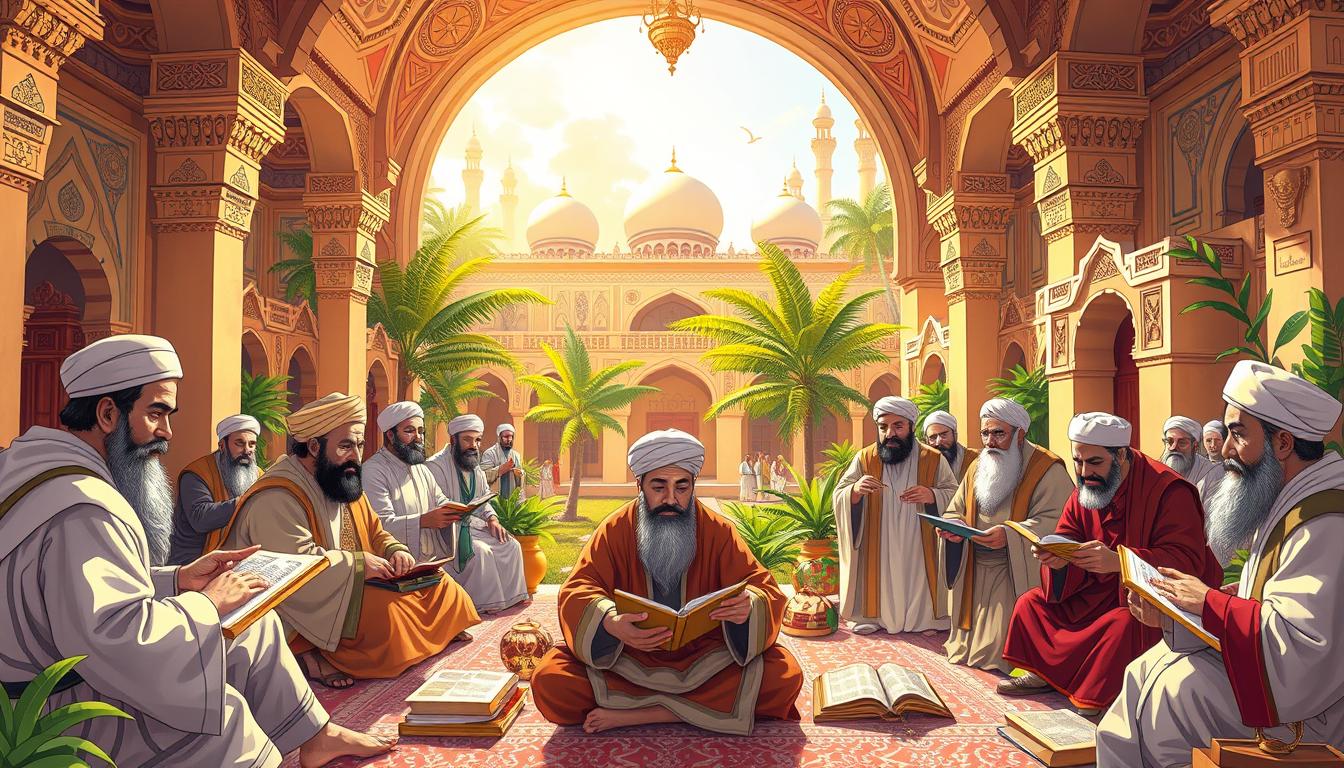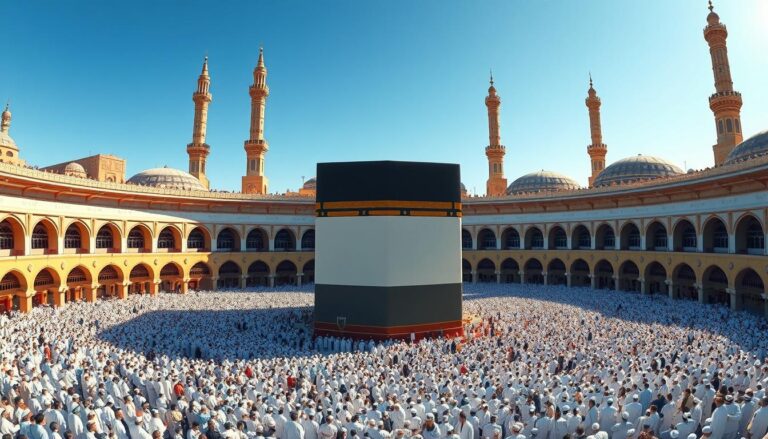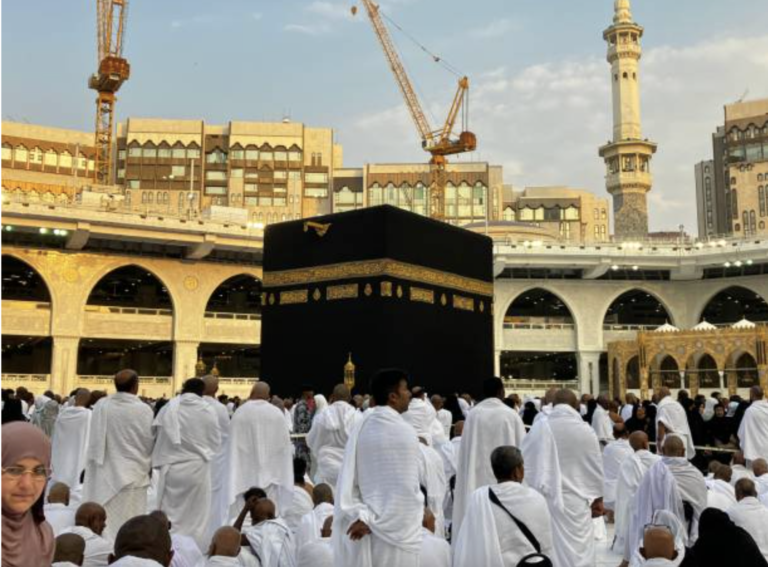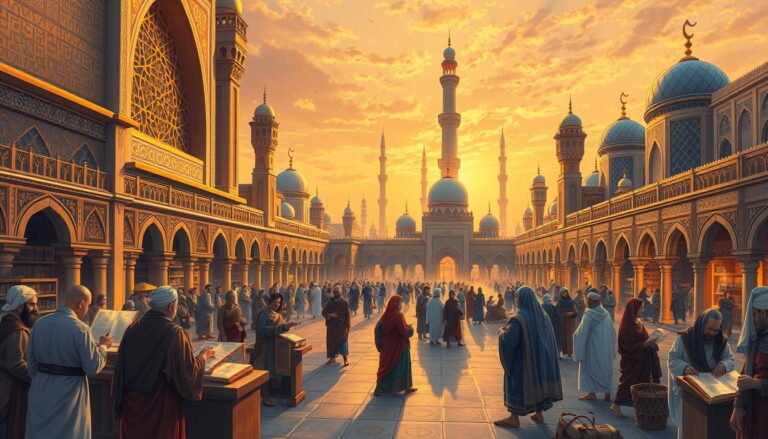Uncovering the Golden Age of Islamic Civilization
Did you know that the roots of modern science and philosophy started in the Islamic world? The Islamic Golden Age, from 750 to 1258 A.D., was a time of great learning and culture. It was when new ideas and inventions changed the world.
During this era, the Islamic Renaissance brought a big change in knowledge. Muslim scholars made huge progress in areas like math and medicine. They didn’t just keep old knowledge; they also explored new ideas.
In Baghdad, the new capital of the Abbasid Caliphate, learning flourished. The House of Wisdom, a big library and translation center, was at the heart of this. It was where ideas from Greece, Persia, and India were shared and studied.
The achievements of Muslim scientists during this time were amazing. They introduced Arabic numerals, which we still use today. They also adopted the concept of zero from India, which then went to Europe. In medicine, they came up with new surgical methods and tools, many of which we still use.
The Golden Age was also a time of great art and literature. Poetry, calligraphy, and architecture reached new levels. Famous stories like “One Thousand and One Nights” were collected during this time. They have captivated people for centuries with their stories of magic and adventure.
Key Takeaways
- The Islamic Golden Age lasted from 750 to 1258 A.D.
- Baghdad’s House of Wisdom was a key center of learning and translation
- Arabic numerals and the concept of zero revolutionized mathematics
- Medical advancements included new surgical techniques and instruments
- The period saw significant artistic and literary achievements
- Multicultural exchange of ideas fueled intellectual growth
The Rise of the Abbasid Caliphate
The Abbasid Caliphate started in 747, a key moment in Islamic history. This dynasty ruled for five centuries. They brought military power, city growth, and intellectual progress.
Founding and Stabilization of the Empire
The Battle of Zab River in 750 ended the Umayyads and started the Abbasid Caliphate. This victory opened a new era of growth and culture.
Establishment of Baghdad as the Capital
Caliph al-Mansur made Baghdad the Abbasid Caliphate’s capital. This move made Baghdad a key spot for trade, learning, and culture.
Cultural and Intellectual Flourishing
Harun al-Rashid’s rule (786-809) started the Islamic Golden Age. Baghdad, Cairo, and Córdoba became centers of learning. The House of Wisdom in Baghdad led to big discoveries.
- Introduction of paper in the 8th century
- Development of algebra by Persian scientist Muhammad ibn Mūsā al-Khwārizmī
- Discoveries in calculus by scholar Alhazen
- Establishment of the Citadel of Science
The Abbasid Caliphate’s impact is still felt today. It was a time of great progress in math, astronomy, medicine, and philosophy. This period greatly influenced global knowledge and science.
The House of Wisdom: A Beacon of Knowledge
The House of Wisdom was a symbol of great learning in the Islamic Golden Age. It was founded in Baghdad in the 8th century. It became the center of a major translation movement that changed human knowledge.
Preserving Ancient Wisdom
The House of Wisdom was key in saving and translating old texts. Scholars worked hard to turn Greek, Persian, and Indian works into Arabic. This saved many important texts from being lost.
A Melting Pot of Ideas
The institution was a place where people from different backgrounds came together. Muslims, Christians, Jews, and scholars of other faiths worked together. This created a unique space for exchanging ideas.
Advancing Scientific Understanding
The translation movement at the House of Wisdom didn’t just save knowledge – it grew it. Scholars reviewed and enhanced the works they translated. This led to big steps forward in astronomy, mathematics, and medicine.
“The House of Wisdom was not just a library, but a beacon of intellectual light that illuminated the path of scientific progress for centuries to come.”
The House of Wisdom’s impact went beyond the Islamic Golden Age. Its work helped start the European Renaissance. It connected ancient wisdom with modern science. Its legacy still inspires scholars and thinkers today.
Uncovering the Golden Age of Islamic Civilization
The Islamic Renaissance lasted from the 8th to the 15th century. It was a time of great creativity and innovation. This was seen in science, mathematics, and medicine.
The House of Wisdom in Baghdad was key to this cultural exchange. Scholars from many backgrounds came together. They translated and studied ancient texts, leading to new discoveries.
In astronomy, Islamic scientists made big strides. The first observatory in Baghdad was built in the 9th century. They created tools like the astrolabe, helping us understand the universe better.
“1001 Inventions: Discover the Muslim Heritage in our World” – an exhibition that traveled to 30 major cities, showcasing over 60 interactive exhibits of Islamic scientific achievements.
Medical knowledge grew a lot during this time. The Comprehensive Book of Medicine collected Islamic medical wisdom. It influenced Europe by the 13th century. Al-Zahrawi created surgical tools still used today, and Ibn al-Nafis found the pulmonary-blood circulatory system.
Mathematics also saw big progress. Muslim scholars introduced algebra and Arabic numerals. These changes helped in architecture and town planning.
The Islamic Golden Age was all about curiosity and innovation. It left a lasting impact on science and culture worldwide.
Scientific Advancements and Discoveries
The Islamic Golden Age was from the 8th to the 14th centuries. It was a time of great Muslim scientific achievements. Scholars made key discoveries in many fields, setting the stage for future breakthroughs in both the Islamic world and Europe.
Mathematics and Algebra
Islamic mathematicians changed the game with their work. Muhammad ibn Musa al-Khwarizmi introduced algebra and algorithms. He also made the Indian numeral system, now called Arabic numerals, popular.
Abu al-Wafa’ al-Buzjani created the first table of sines. This helped advance trigonometry and made astronomical calculations easier.
Astronomy and Physics
Islamic astronomers made big strides in understanding the universe. Al-Battani developed accurate ways to measure planets and stars. His work was a big step forward.
Ibn al-Haytham, known as the father of modern optics, wrote “Book of Optics” in the 11th century. His work on optics was groundbreaking and challenged old theories about vision.
Medicine and Chemistry
Medicine saw huge leaps during this time. Ibn Sina, or Avicenna, wrote “Canon of Medicine.” It was a detailed medical guide that was used in Europe for centuries.
In chemistry, Jabir Ibn Hayyan, known as the father of chemistry, made big contributions. He worked on alchemy and classifying chemical substances.
“The Islamic Golden Age was a period of unparalleled scientific progress, where scholars from diverse backgrounds collaborated to push the boundaries of human knowledge.”
These achievements by Muslim scholars not only kept ancient knowledge alive but also helped spark the scientific revolution in Europe. Their legacy still inspires scientists and researchers today.
Islamic Art and Architecture
The Islamic Golden Age lasted from 750 to 1500 A.D. It was a time of great cultural achievements in art and architecture. This era introduced unique styles that still amaze us today.
Islamic art avoided human figures in religious settings. Instead, it focused on intricate geometric patterns and beautiful calligraphy.
Islamic architecture took inspiration from the Byzantine Empire. Domes and arches became common in grand mosques and palaces. The Alhambra in Granada, Spain, is a prime example of this artistic genius. Its walls feature stunning arabesque patterns and colorful mosaics.
In Seville, the Alcazar showcases the Mudejar style. This style combines Islamic design with Spanish Christian architecture. The result is a stunning blend of cultures.
“Islamic art is a mirror of the invisible world.”
Islamic architects introduced new design elements. They used the pointed arch and intricate tile work. These features were not just for religious buildings but also for public spaces.
The qalam, a pen made from dried reed or bamboo, was key for Arabic calligraphers. Their work decorated everything from manuscripts to coins.
- Geometric patterns
- Calligraphy
- Arabesque designs
- Intricate tile work
The cultural achievements of this era still inspire us. Islamic art and architecture are lasting symbols of a golden age of creativity and innovation.
The Role of Caliphs in Fostering Knowledge
The Abbasid Caliphate was key in the Islamic Golden Age. Leaders like Harun Al-Rashid and Al-Ma’mun helped create a place for learning and growth.
Harun Al-Rashid’s Patronage of Scholars
Harun Al-Rashid ruled from 786 to 809 CE. He was surrounded by wise people. He started the House of Wisdom in Baghdad, a hub for translation and research.
Al-Ma’mun’s Promotion of Rational Thought
Al-Ma’mun ruled from 813 to 833 CE and was a scholar. He sent teams to get texts from other cultures. He also supported rational thinking and Mu’tazilite ideas.
Support for Translation and Research
The caliphs supported knowledge greatly. They funded translations, research, and libraries. This led to big steps forward in math, astronomy, and medicine.
“The first hospital in Cairo in the 9th century combined care for the ill with physicians’ education and was open to all regardless of wealth.”
The Abbasid caliphs’ love for learning changed the world. Their support drew scholars from everywhere. This created a culture of innovation that lasted for centuries.
Cultural Exchange and Trade Along the Silk Road
The Silk Road trade routes were key in cultural exchange and economic growth during the Islamic Golden Age. This vast network connected the Islamic civilization with China, India, and Europe. It created a melting pot of ideas, goods, and technologies.
Baghdad, the capital of the Abbasid Caliphate, became a major hub along the Silk Road. By 814, it was the world’s largest city with over one million people. Its location between Asia and Europe made it perfect for overland trade.
The Silk Road helped exchange many goods:
- Soap
- Honey
- Diamonds
- Silk
- Glass
- Tiles
Cultural exchange along the Silk Road led to big advancements. Baghdad started the first paper mill in the Islamic world, thanks to Chinese travelers. The House of Wisdom became a center for translating ancient texts, preserving and expanding knowledge.
Islamic civilization spread worldwide through these trade routes. By the 1300s, many in southern India, Indonesia, and Malaysia had converted to Islam. The exchange of ideas also led to scientific progress. Arab mathematicians popularized the Indian number system with zero and invented algebra, while Islamic astronomers improved the astrolabe for navigation.
The Silk Road’s legacy lives on today. Historic buildings and monuments along its paths show its lasting impact on culture and economy.
Philosophical and Religious Developments
The Islamic Golden Age was a time of great thought. Muslim thinkers mixed Greek wisdom with Islamic teachings. This created a new philosophy that combined faith and reason.
The Rise of Islamic Philosophy
In the 9th century, Islamic philosophy began to grow. Al-Kindi, known as the “Philosopher of the Arabs,” was a key figure. He explored big questions about existence, knowledge, and ethics.
Theological Debates and Schools of Thought
Theological debates were common during this era. The Mu’tazilites believed in using reason in religious matters. They argued for free will and questioned strict interpretations of religious texts.
The Asharites, however, wanted to balance reason with traditional beliefs. These debates shaped Islamic theology and influenced Western philosophy.
Influence on Western Philosophy
Islamic philosophy had a big impact on Western thought. Muslim scholars preserved and expanded on ancient Greek works. Their ideas on logic, ethics, and metaphysics reached Europe through translations.
“The ink of the scholar is more sacred than the blood of the martyr.” – Prophet Muhammad
The Golden Age also saw the rise of Sufism, Islamic mysticism. Sufis sought a direct, personal experience of the divine. Their teachings enriched Islamic spirituality and influenced both Eastern and Western mystic traditions.
Conclusion
The Islamic Renaissance, from the 8th to the 15th century, had a huge impact on the world. The Abbasid Caliphate grew to be bigger than the Roman Empire. Baghdad, its capital, became the world’s biggest city, full of amazing buildings and learning.
The legacy of the Islamic Golden Age is seen in many areas. The House of Wisdom in Baghdad was a place where ideas from all over mixed. It led a big effort to translate old knowledge, thanks to paper from China.
Science made big strides during this time. Al-Khwarizmi’s work in algebra and the use of the Indian numeral system in Europe show its impact. Muslim engineers built cool things like clocks, robots, and water pumps. Their work in art and architecture, like the Alhambra and the Alcazar of Seville, is still admired today.
The Islamic Golden Age was all about open minds and thinking clearly. This laid the foundation for more learning and discovery in the future. Its legacy reminds us of the importance of sharing ideas and seeking knowledge.
Source Links
- What is the Golden Age of Islam Handout
- The History and Achievements of the Islamic Golden Age Season 1 Episodes Streaming Online | Free Trial | The Roku Channel | Roku
- The Arab Expansion and the Islamic Golden Age: A Legacy of Knowledge and Cultural Flourishing | SchoolTube
- Islam’s ‘Golden Age’ – Rise of the Abbasids (Video)
- The Islamic Golden Age | World Civilization
- The House Of Wisdom Summary PDF | Jonathan Lyons
- The House of Wisdom- Bayt al Hikma
- The Air of History Part III: The Golden Age in Arab Islamic Medicine An Introduction
- Uncovering A Thousand Years of Science and Technology – Muslim Heritage
- Astronomy in the medieval Islamic world
- Science in the medieval Islamic world
- Islamic Golden Age | Islamic History
- An Inspiring Tale of Science, Art, and Philosophy – History Adventures
- History and Achievements of the Islamic Golden Age
- The Great Caliphs The Golden Age of the ‘Abbasid Empire
- Islam – Rise of the Religion and Empires
- Medieval Islamic civilisations – Medieval Islamic civilisations – KS3 History – homework help for year 7, 8 and 9. – BBC Bitesize
- About the Silk Roads | Silk Roads Programme
- The golden age of islam2
- The House of Wisdom: Interdisciplinarity in the Arab-Islamic Empire
- Islamic Contributions to Global Culture and Civilization
- Wetenschapsschool: Natuurkunde voor de middelbare school
- From Rome to Baghdad – The Golden Age of Islam







